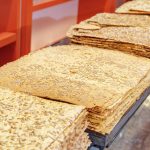Bread baking is both an art and a science, involving a series of chemical and physical changes that transform simple ingredients into a flavourful, aromatic loaf. Here are the key scientific principles behind the process:
Ingredients and Their Roles
- Flour:
- Proteins: Flour contains proteins, primarily glutenin and gliadin, which combine with water to form gluten. Gluten provides structure and elasticity to the dough.
- Starch: Starch granules absorb water and swell, contributing to the dough’s texture and providing food for yeast.
- Water:
- Hydrates the flour proteins to form gluten.
- Activates yeast.
- Dissolves salts and sugars.
- Yeast:
- Fermentation: Yeast ferments sugars in the dough, producing carbon dioxide (CO₂) and ethanol. The CO₂ gas gets trapped in the gluten network, causing the dough to rise.
- Flavor Development: Yeast fermentation produces organic acids and other compounds that enhance the bread’s flavor.
- Salt:
- Enhances flavor.
- Strengthens gluten structure, making the dough more elastic.
- Regulates yeast activity, preventing over-fermentation.
- Sugar:
- Feeds the yeast, increasing fermentation.
- Promotes browning and adds sweetness.
- Fats (optional):
- Improve texture and moisture.
- Slow down staling.
The Bread Baking Process
- Mixing:
- Hydration of flour: Water combines with flour proteins to form gluten.
- Initial gluten development: Mixing aligns the gluten strands, forming a network.
- Kneading:
- Further develops gluten, making the dough elastic and smooth.
- Distributes yeast and other ingredients evenly.
- Fermentation (First Rise):
- Yeast ferments sugars, producing CO₂ and ethanol.
- Dough expands as CO₂ gets trapped in the gluten network.
- Organic acids and alcohols produced during fermentation contribute to flavor.
- Punching Down:
- Releases excess CO₂.
- Redistributes yeast and nutrients.
- Equalizes the dough temperature and texture.
- Shaping:
- Dough is shaped into the desired form, ensuring even baking.
- Proofing (Second Rise):
- Final fermentation period, allowing the dough to rise further.
- Creates a fine network of air pockets, leading to a light, airy texture.
- Baking:
- Oven Spring: Initial rapid rise due to expanding gases and steam.
- Starch Gelatinization: Starch granules absorb water and swell, contributing to the bread’s structure.
- Protein Coagulation: Gluten proteins set, giving the bread its final shape and structure.
- Maillard Reaction and Caramelization: Browning reactions that develop the crust’s color and flavor.
- Cooling:
- Bread continues to set as it cools.
- Moisture redistributes, enhancing the texture.
The Physical and Chemical Changes In Baking
Bread, like any baked product is prepared by a process where heat transfer is the dominant process and where its temperature is the dominant factor. The other transfer process is mass transfer which sees movement of moisture and gas. The effect on the dough or batter being baked is a mix of chemical and physical transformations that alter the structure of the dough.
In the baking process, whether it is through yeast leavening or chemical leavening, the change in temperature produces different physicalchemical changes in the dough. There is:-
- carbon dioxide production
- changes in gluten,
- starch gelatinization
These changes produce expansion of gas bubbles and the product volume increases. The other reactions are formation of crust and browning through Maillard browning and sugar caramelization.
Dough Rheology & Aeration
Rheology and the degree of aeration are very closely linked. Any changes in dough rheology during development is affected by the incorporation of gas bubbles and how these develop into gas cells when the bread is baked. Likewise, mixing is a critical process function especially at the end of this process because of the impact it has on gas cell structure in the baked bread. The Chorleywood Bread Process (CBP) is possibly the technology which is most influential on gas structure. The doughs are fully and properly developed in the mixer itself. No punching is needed and moulding occurs before any particular yeast activity occurs.
Measurements of Rheology
The measurement of dough rheology is well defined and explained. They are split into fundamental and empirical techniques (Dobraszczyk & Morgenstern, 2003).
Bubbles, especially their size distribution are determined using microcomputed tomography which allows for three-dimensional visualization of the internal dough structure. Bubble structure can be resolved to 10 microns in diameter. Bubbles in dough are studied because how they nucleate in dough during mixing is the first step because they are the only nuclei available for subsequent gas cell growth (Baker and Mize, 1941).
The growth and coalescence of bubbles has been explored using X-ray tomography.
Key Scientific Concepts
- Gluten Development:
- Gluten provides the structural framework of bread. Kneading helps align gluten strands, creating a network that traps CO₂.
- Fermentation:
- Yeast fermentation produces CO₂ and ethanol. CO₂ causes the dough to rise, while ethanol and other byproducts contribute to flavor.
- Enzymatic Activity:
- Enzymes in flour (amylase) break down starches into sugars, providing food for yeast and enhancing fermentation.
- Browning Reactions:
- The Maillard reaction (between amino acids and reducing sugars) and caramelization (sugar breakdown) contribute to the crust’s color and flavor.
Troubleshooting Common Issues
- Dense Bread:
- Insufficient kneading, under-proofing, or not enough yeast.
- Flat Bread:
- Over-proofing, weak gluten network, or over-handling the dough before baking.
- Crust Issues:
- Pale crust: Insufficient baking time or temperature.
- Too thick: Overbaking or high sugar content in the dough.
Understanding these principles helps bakers control the outcome and troubleshoot problems, resulting in consistently excellent bread.
References
Dobraszczyk BJ and Morgenstern MP. (2003) Review: Rheology and the breadmaking process. J. Cereal Sci. 38 pp. 229–245
Hibberd, G.E. and Parker, N.S. (1975) Measurement of the fundamental rheological properties of wheat-flour doughs. Cereal Chem. 52 pp. 1r–23r
Muller H.G. (1975) Rheology and conventional bread and biscuit making process. Cereal Chem. 52 pp. 89r–105r



Leave a Reply